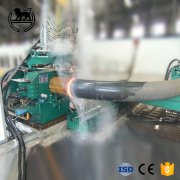Chinese | English

Skype: zhiguang.wu
Email:15230713671@163.com
Address: North Mengcun Industrial Park, Mengcun Hui Autonomous County, Cangzhou, Hebei.
The bending size of the medium frequency pipe bender
Medium frequency pipe bender is a kind of equipment used for processing metal pipes, which can bend straight pipes into bent pipes of various shapes and angles. Bend size refers to the size and geometry of the bend, including bending radius, bending Angle, bending length and other parameters. The following will detail the bending size of the medium frequency pipe bender and its influencing factors.
1. Bending radius: medium frequency pipe bending machine can achieve different bending radius of pipe processing. Bending radius refers to the distance between the central axis of the bend and the outer surface of the bend. In general, the smaller the bending radius, the greater the bending degree of the bend, and vice versa. The choice of bending radius depends on the specific application requirements and the nature of the pipe.

2. Bending Angle: medium frequency pipe bending machine can achieve different bending angles from several degrees to 180 degrees. The bending Angle is the Angle between two adjacent pipe segments. The choice of bending Angle is determined according to the specific engineering requirements and the material of the pipe. In the selection of bending Angle, it is necessary to consider the pipeline fluid flow performance after bending, strength and wear resistance of the pipe and other factors.
3. Pipe bending length: The medium frequency pipe bending machine can process different lengths of pipe bending, which can be customized according to actual needs. The length of a bend refers to the total length of a bend after bending. The choice of bend length is related to the specific engineering requirements and pipeline layout. Under normal circumstances, a long bend length can reduce the fluid resistance, but it will also increase the cost and installation difficulty of the pipeline.
In addition to the above three main parameters, the bending size of the medium frequency bending machine can also include the bending wall thickness, bending diameter and so on. Bending wall thickness refers to the thickness of bending wall, which has a great influence on the strength and pressure resistance of bending pipe. Pipe bend diameter refers to the outside or inside diameter of the pipe bend, which affects the flow rate and velocity of the pipe. The selection of these parameters needs to take into account the engineering requirements, the properties of the pipe and the capability of the processing equipment.
In short, the bending size of the medium frequency pipe bender is determined according to the specific engineering requirements and the nature of the pipe. Through reasonable selection of bending radius, bending Angle, bending length and other parameters, the precise control of bending pipe can be achieved to meet the needs of different projects.
